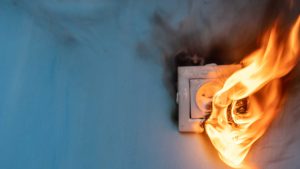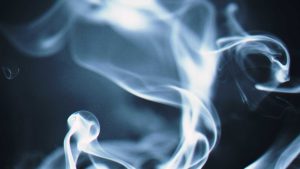Table of Contents
A bit of innocuous smoke could be the start of a major fire.
Safety codes and regulations set the standard for ventilation and smoke detectors, and landlords are responsible for ensuring the safety and reliability of those systems.
In turn, tenants are expected to abide by the lease agreement and abstain from smoking or leaving out candles.
But what happens when all of that goes wrong?
Here’s everything you need to know about dealing with smoke damage and restoring the security of your home.
Signs of Smoke Damage
 The more subtle the damage, the more challenging it is to identify the source of smoke.
The more subtle the damage, the more challenging it is to identify the source of smoke.
Exacerbated fires will leave behind obvious marks, such as large soot stains on surfaces or warped and cracked walls. This kind of visible damage is more explicable and straightforward for the involved parties to process and the insurance companies to investigate.
Sometimes, smoke damage is the walls changing to a slightly different shade. Seemingly benign exposure can leave behind enough soot to discolour surfaces. The smaller the source of smoke, the less apparent the discolouration is as it blends in with the rest of the surface.
Easily identifiable are the odours produced by smoke and its possible sources. A dangerous worst-case scenario is a smoke leak that occurs slowly and gradually enough that you don’t notice the smell. That’s what smoke and carbon monoxide detectors are for.
For landlords inspecting their tenants’ properties, it’s easy to determine if someone’s been smoking. The iconic odour sticks to most fabrics, which means it can be found near sofas, curtains, and lampshades.
Just as notable is any residue left behind, such as soot and ash. Those will persist in emitting smokey odours. The source of the smoke damage will likely be within the vicinity of such remnants.
Repairing Damage Caused by Smoke Exposure

Smoke and fire hazards can cause quite a bit of harm, so turning to professional restoration services is important. It’s important for someone with experience to assess the damage as they’re likely to gauge the severity of the situation and anything else the landlord or tenant missed. If the damage isn’t all that extensive or the only issue is soot or ash, an end of tenancy cleaning company can accurately assess the situation and help with the cleaning.
They will use specialised equipment to remove any leftovers from the problem areas and purify the air to eliminate smoke odours.
Restoration teams will remove and replace damaged surfaces and repair the electrical system and any affected appliances. They’ll also check and ensure the proper functionality of your house ventilation system.
Insurance companies come with their own procedures regarding repairs which are helpful in streamlining the process and providing clarity on potential costs.
How to Deal With Smoke Damage in Your Rental Property
 1. Contact your insurance company
1. Contact your insurance company
As mentioned, the importance of reporting such an incident can alleviate quite a bit of the stress of dealing with it.
More often than not, they mitigate the circumstances caused by the issue and might also help tenants find a place to stay while the investigation and repairs are administered.
Insurance adjusters visit the incident site to determine the damage’s scope and evaluate the claim accordingly.
Landlords must comply with the instructions provided by the insurance company when addressing tenants’ damaged property.
Likewise, the tenant must be transparent and communicative in fulfilling their lease agreement by working with the insurance company and landlord to file accurate claims.
Both parties are allowed to work with contractors and express their concerns about the timeframe of restoring and repairing the damaged property and where they will stay during that period.
Landlords naturally want no interruption in this process to get their property back on the market as soon as possible.
2. Contact the fire restoration company
Like the ones above, fire restoration electric companies assess the damage and the source first before they repair it and restore the property to its original condition.
Depending on the damage, restoration can take a lot of time and will likely require the premises to be vacated.
Ideally, tenants should have somewhere to stay if assisted by the insurance company so that the restoration and take place efficiently. The company’s services include structural repairs and the removal of debris and soot, as well as any harmful gases and lingering odours.
Tenants can count on professionals to do everything in their power when attempting to salvage and restore their personal belongings. While expecting the full restoration of every item is unrealistic, insurance companies can at least provide compensation for what was destroyed.
Landlords can count on effective inspections done by the restoration company. All parties must coordinate clearly to reach the best possible resolution.
3. Help your tenants
Landlords should also encourage tenants to carry out routine maintenance of their home’s systems, especially if they don’t so themselves.
Learning how to check for faults in electrical grids or glitches in the smoke detection system can save not only money but, more importantly, your life.
Nevertheless, entrusting that task to professional safety inspectors is probably what’s best.
If damage has already happened, HVAC technicians and electricians can restore failed or affected systems.
Insurance will cover the required services, but landlords should also take the initiative when handling their legal responsibilities, such as repairing the structural integrity of the building.
4. Secure the property
To ensure that the insurance claim is fair and accurate, all parties must not alter the scene of damage in any way until all investigations and assessments are complete.
Any alterations could potentially hinder and affect the legitimacy of the claim.
Who is Responsible for the Repair Costs
 As mentioned above, transparency and communication are important, so is accountability. In situations like these, many feel discouraged from taking responsibility for their actions.
As mentioned above, transparency and communication are important, so is accountability. In situations like these, many feel discouraged from taking responsibility for their actions.
The lease agreement effectively sets ground rules and outlines each party’s responsibilities.
Disputes are unnecessary when a clear violation of that agreement occurs, such as tenants smoking on the property, leaving the stove unattended, or landlords obliviously providing faulty electrical or heating systems.
Violations by tenants can entitle landlords to end their tenancy immediately.
Ultimately, insurance companies determine and assign responsibility according to their investigation, regardless of whether it was a clear-cut situation or not.
Usually, the landlord takes care of the property’s structural repairs while the tenant assumes responsibility for repairing their belongings. Insurance helps mitigate the incident’s consequences in either case, so all parties should feel encouraged to participate in the outlined process.
Main takeaways
The expediency of communication between the landlord and tenants is imperative to streamline the process of claiming insurance and restoring the property and any personal belongings.
Landlords should explicitly inform their tenants about their non-smoking policy and how smoke damage and exposure can render the home uninhabitable, cost a lot to repair, or even result in a tragedy.
Ensure the property is well-maintained all year round and that you contact all the necessary companies when it’s in need of repairs.


